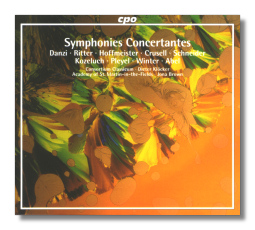
The Internet's Premier Classical Music Source
Related Links
- Latest Reviews
- More Reviews
-
By Composer
-
Collections
DVD & Blu-ray
Books
Concert Reviews
Articles/Interviews
Software
Audio
Search Amazon
Recommended Links
Site News
 CD Review
CD Review
Symphonies Concertantes

- Bernhard Henrick Crusell: Sinfonia Concertante for Clarinet, Horn & Bassoon, Op. 3
- Georg Abraham Schneider: Sinfonia Concertante for Violin & Viola, Op. 19
- Franz Danzi: Sinfonia Concertante for Flute & Clarinet, Op. 41
- Franz Anton Hoffmeister:
- Sinfonia Concertante for 2 Clarinets in E Flat Major
- Sinfonia Concertante for Clarinet & Bassoon
- August Ritter: Sinfonia Concertante for 2 Bassoons
- Peter Von Winter: Sinfonia Concertante for Violin, Clarinet, Horn & Bassoon
- Carl Friedrich Abel: Sinfonia Concertante for Violin, Oboe & Clarinet
- Ignaz Joseph Pleyel: Sinfonia Concertante for Violin & Piano, Op. 57
- Leopold Antonín Koželuch: Sinfonia Concertante for Piano, Mandolin, Trumpet & Bass in E Flat Major
Consortium Classicum/Dieter Klöcker
Academy of St. Martin-in-the-Fields/Iona Brown
CPO 777009-2 ADD 3CDs: 72:15, 74:52, 68:56
This collection of ten Classical symphonies concertantes was recorded (quadraphonically!) in 1977 and issued as a five-record set by EMI Electrola. Now it has been licensed by CPO and reissued economically on just three CDs.
The sinfonia concertante arose in the latter half of the 1700s as the successor to the Baroque concerto grosso. By 1830, it had pretty much run its course. Essentially, it is a concerto in which there are two or more soloists (Leopold Jan Antonín Koželuch's calls for four – piano, mandolin, trumpet, and double bass!), and in which the contrast between the soloists and rest of the musicians is less pronounced than it would be in a true concerto. In that sense, it has as much to do with chamber music as it does with the symphonic genre. The sinfonia concertante is something of a hybrid, then, but even once one moves beyond Mozart's and Haydn's contributions to the genre, there is much to enjoy and admire. The music on these discs is not profound, but it rests graciously in the ear, and it looks both backwards and forwards in interesting ways. In his booklet notes (reprinted from the LP set, but without the illustrations), Dieter Klöcker remarks that not a single sinfonia concertante was written in a minor key, as far as he knows. All ten of these works are in three movements, with a relatively long opening movement giving way to two shorter movements, the middle one in a slower tempo.
Again, according to Klöcker, these ten sinfonias concertantes are not intended to be representative of the genre. Instead, Klöcker and Consortium Classicum (on this recording, an ensemble of soloists) chose to represent different cities or regions in Europe, from Stockholm (Bernhard Henrik Crusell) to Vienna and Prague (Koželuch and Franz Anton Hoffmeister). The instrumental combinations are frequently unexpected (Koželuch's work, for example) and always delightful!
This set was desirable on LP, and it is no less so now. The soloists play stylishly, and Brown and the Academy give them excellent support. These works are played on modern instruments, but with a feel for period style. As sometimes is the case with the Academy, a feeling of sameness and smoothness can creep into the music-making, but limit your listening to one or two of the works at a time and you will find the experience pleasant indeed. The warm analog sound has held up excellently. (Of course the quad is gone!)
Copyright © 2004, Raymond Tuttle



















